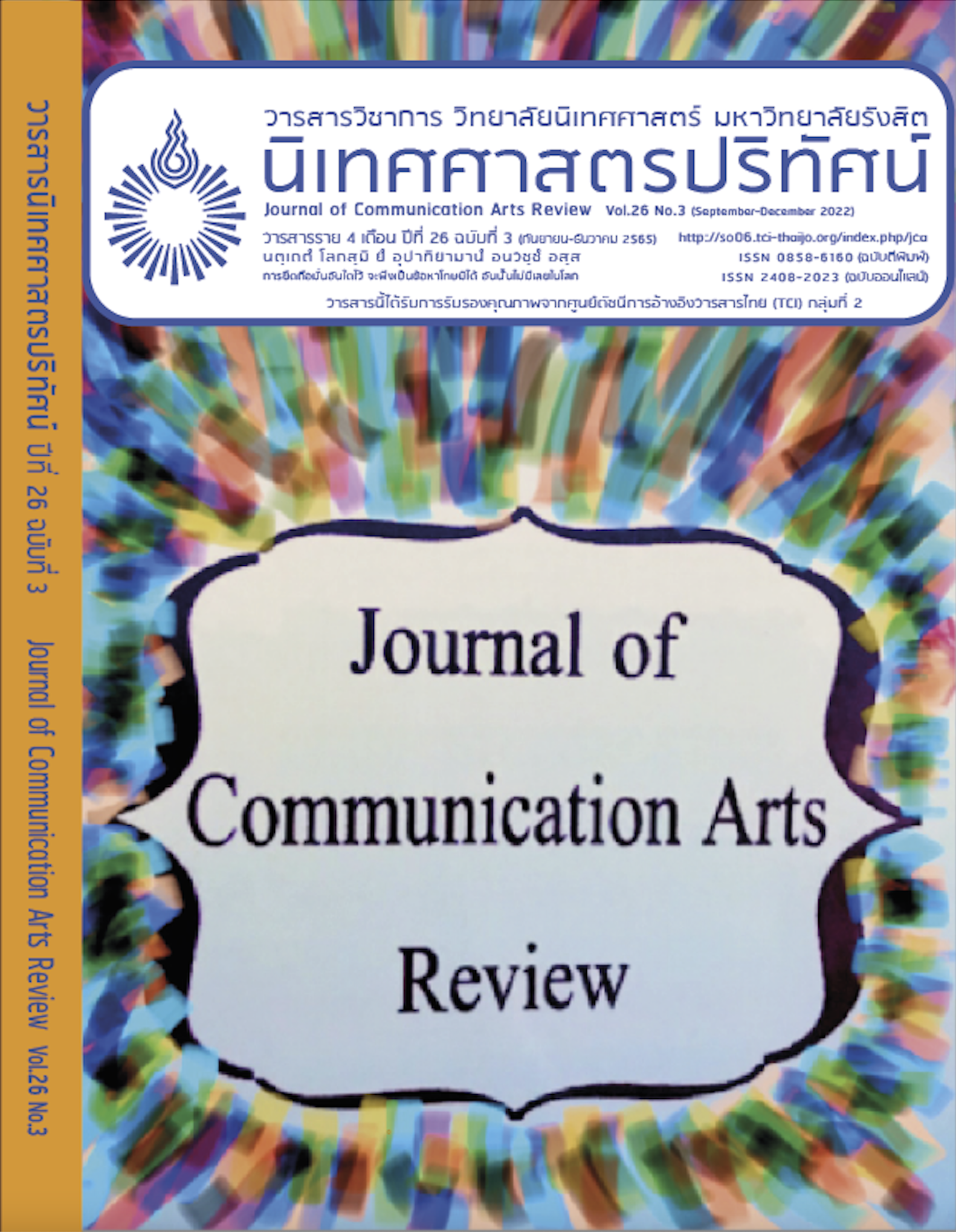การพัฒนารูปแบบการออกแบบตราสินค้าไลฟสไตล์
คำสำคัญ:
รูปแบบ, การออกแบบ, ตราสินค้าไลฟสไตล์บทคัดย่อ
การวิจัยครั้งนี้มีวัตถุประสงค์เพื่อพัฒนาและทดสอบแนวคิดรูปแบบการออกแบบการสื่อสารตราสินค้าไลฟ์สไตล์ เพื่อเป็นแนวทางให้ผู้บริหารตราสินค้าและนักสื่อสารการตลาดได้ใช้การออกแบบสำหรับเป็นเครื่องมือในการพัฒนาผลิตภัณฑ์ตราสินค้าไลฟ์สไตล์ของตนให้ตอบโจทย์ตามความต้องการของผู้บริโภค
การวิจัยครั้งนี้ใช้วิธีการวิจัยเชิงคุณภาพด้วยการสนทนากลุ่มจากผู้ที่เกี่ยวข้อง คือ ผู้เชี่ยวชาญที่เป็นนักออกแบบ, นักการตลาด, ผู้บริหาร, ผู้เชี่ยวชาญด้านการออกแบบตราสินค้าและนักนิเทศศาสตร์จำนวน 48 คน ผลการวิเคราะห์พบว่าองค์กรควรใช้การออกแบบเพื่อกระบวนการพัฒนาผลิตภัณฑ์หรือบริการใหม่ ในการคิดเชิงนักออกแบบนั้นควรเปลี่ยนเป็นการคิดไปข้างหน้า นักออกแบบควรมีส่วนร่วมในทุกขั้นตอนของการพัฒนาผลิตภัณฑ์ใหม่ โดยนำกระบวนการผลิตภัณฑ์ที่มีคุณสมบัติสำคัญน้อยที่สุดที่สามารถซื้อขายได้มาใช้เฉพาะในผลิตภัณฑ์ที่เหมาะสม และควรสื่อสารการตลาดแบบครบวงจรด้วยสื่อทั้งออนไลน์และออฟไลน์ โดยสร้างให้ผู้บริโภคมีประสบการณ์กับตราสินค้า
เอกสารอ้างอิง
กมลชนก เศรษฐบุตร. (2565). การวิเคราะห์รูปแบบการออกแบบเพื่อการสื่อสารตราสินค้าไลฟ์สไตล์. วารสารวิจัยรำไพพรรณี. 16(1) :200-210.
เก็จกนก เอื้อวงศ์ และพิชิต ฤทธิ์จรูญ. (2556). หน่วยที่ 2 วิธีวิจัยทางการบริหารการศึกษา. ในประมวลสาระชุดวิชา 23721 การวิจัยทางการบริหารการศึกษา (หน่วยที่ 1-5. น. 2-15 ถึง 2-118). นนทบุรี: สาขาวิชา ศึกษาศาสตร์ มหาวิทยาลัยสุโขทัยธรรมาธิราช.
ณัฐพงศ์ คงประเสริฐ. (2558). การออกแบบผลิตภัณฑ์เพื่อให้ตอบสนองกับความต้องการของลูกค้า. วารสารวิศวกรรมศาสตร์ มหาวิทยาลัยศรีนครินทรวิโรฒ, 10(1): 55-65.
ธนาคารกรุงเทพ (2563). 6 กลุ่มสินค้าไลฟ์สไตล์มาแรงจากกระแส New Normal สืบค้น 15 พ.ย. 2564, จาก https://www.bangkokbanksme.com/en/lifestyle-products-new-normal-trend
วรรณยศ บุญเพิ่มและไตรรัตน์ สิทธิกูล. (2559). กลยุทธ์การออกแบบเพื่อการขับเคลื่อนธุรกิจ: กรณีศึกษาคณะผู้บริหารและเจ้าของกิจการในธุรกิจ SMEs ในประเทศไทย. วารสารวิชาการนวัตกรรมสื่อสารสังคม, ปีที่ 4, 2(8): 144 – 151.
เอกจิตต์ จึงเจริญ. (2553). “กลยุทธ์บริหารการออกแบบ” สู่ความสำเร็จของธุรกิจยุคใหม่. วารสารบริหารธุรกิจ, 33(128): 7-13.
Akerlof, G. (1970). The Market for Lemons: Quality Uncertainty and the Market Mechanism. Quarterly Journal of Economics, 84, 488 – 500.
Brandis. (2020). Lifestyle Brand. Retrieved July 18, 2022. From https://www.brandis76.com/ single-post/2017/03/16/lifestyle-brand#:~:text=ลักษณะของไลฟ์สไตล์แบรนด์,ทำงาน%20กลุ่มคนรุ่นใหม่
Centre, T. D. D. (2011). Design Ladder. Retrived December 21, 2020, from http://www. seeplatform.eu/casestudies/Design%20Ladder
Cooper, Rachel Davies 1994. “Marketing and Design: A critical Relationship” in Ian Wilson (ed) Marketing Interfaces Exploring The Marketing and Business Relationship. London: Pitman pp. 127 – 168.
Design_Council. (2020). Making life better by design: Design Council’s story of impact. Retrieved February 2, 2021, from https://www.designcouncil.org.uk/our-impact.
Gemser, G. and Mark L. (2001). How Integrating Industrial Design In the Product Development Process Impacts on Company Performance. Journal of Product Innovation Management, 18: 28 – 38.
Hertenstein, Julie H., Marjorie B. Platt and David R. Brown (2001). Valuing design: Enhancing Corporate performance Through Design Effectiveness. Design Management Journal, 12(3): 10 – 23.
Homburg, Christian, John P. Workman and Harley K. (1999). Marketing’s Influence Within the Firm. Journal of Marketing, 63(2): 1 – 17.
Jones, T. and Rachel, C. (1995). Communication in New Product Development: Perceptions of Inter-Functional Information Flow. R&D Conference 1995, Scuola Superiore S. Anna Pisa. 20-33 September.
Kotler, P. and George R. (1988). Design: a powerful but neglected Tool. The Journal of Business Strategy, Autumn, 16 – 21.
Kotler, P., Kartajaya, H., and Setiawan, I., (2017). Marketing 4.0- Moving from Digital to Traditional. New Jersey: John Wiley & Sons, Inc.
Kristensen, T. and Grønhaug, K. (2007). Can design improve the performance of marketing management? Journal of Marketing Management, 23(9-10): 815-827.
Positioning. (2019). เอ็นอีเอเผย 5 กลุ่มสินค้าไลฟ์สไตล์ขายดีปี 2019 พร้อมเดินหน้าจัดงาน STYLE Bangkok. Retrieved February 2, 2021, from https://positioningmag.com/1225509.
Ries, E. (2011). The Lean Startup: How Today’s Entreprenurs Use Continuous Innovation to Create Radically Successful Businesses. New York: Crown Business. Shiv, B., Antoine B., Irwin L., Joseph W. A., James R. B., Laurette D., Alice I., Barbara M., Ale S.,
Susan J. G and A. Peter McGraw (2005). Decision Neuroscience. Marketing Letters,16(3-4), 375 – 386.
TCDC. (2016). TCDC Outlook. Bangkok: Sunta Press Co., Ltd.
ดาวน์โหลด
เผยแพร่แล้ว
ฉบับ
ประเภทบทความ
สัญญาอนุญาต
ลิขสิทธิ์ (c) 2022 วารสารนิเทศศาสตรปริทัศน์

อนุญาตภายใต้เงื่อนไข Creative Commons Attribution-NonCommercial-NoDerivatives 4.0 International License.


